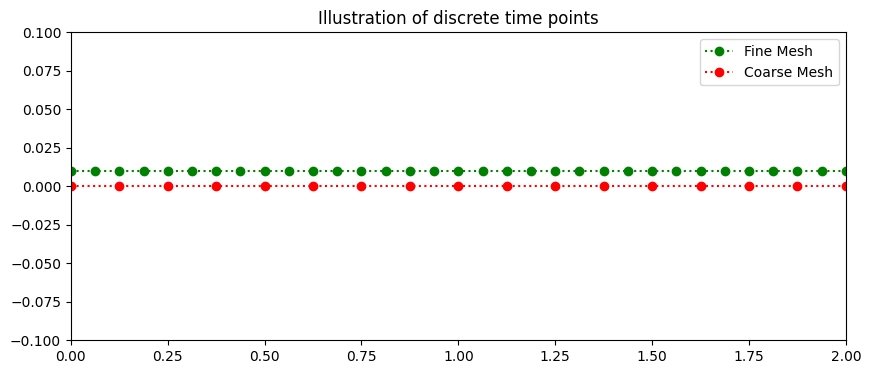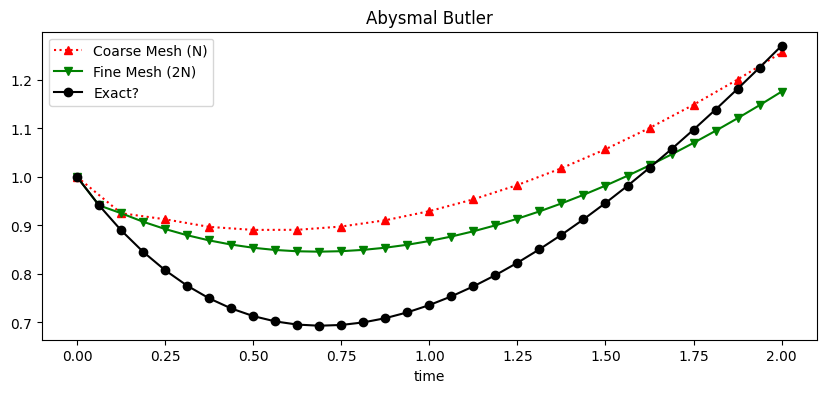Convergence of a Multistep Method#
John S Butler#
john.s.butler@tudublin.ie
Course Notes Github
Overview#
A one-step or multistep method is used to approximate the solution of an initial value problem of the form
with the initial condition
The method should only be used if it satisfies the three criteria:
that difference equation is consistent with the differential equation;
that the numerical solution convergent to the exact answer of the differential equation;
that the numerical solution is stable.
In the notebooks in this folder we will illustate examples of consistent and inconsistent, convergent and non-convergent, and stable and unstable methods.
Introduction to Convergence#
In this notebook we will illustate an non-convergent method. The video below outlines the notebook.
from IPython.display import HTML
HTML('<iframe width="560" height="315" src="https://www.youtube.com/embed/skJSvK52nq0" frameborder="0" allow="accelerometer; autoplay; clipboard-write; encrypted-media; gyroscope; picture-in-picture" allowfullscreen></iframe>')
/Users/johnbutler/opt/anaconda3/lib/python3.8/site-packages/IPython/core/display.py:724: UserWarning: Consider using IPython.display.IFrame instead
warnings.warn("Consider using IPython.display.IFrame instead")
Definition#
The solution of a multi-step methods \(w_i\) is said to be convergent with respect to the exact solution of the differential equation if
All the Runge Kutta, Adams-Bashforth and Adams-Moulton methods are convergent.
2-step Abysmal Butler Multistep Method#
This notebook will illustrate a non-convergent multistep method using the Abysmal-Butler method, named with great pride after the author. The 2-step Abysmal Butler difference equation is given by
The final section of this notebooks shows that the method is non-convergent for all differential equations.
Intial Value Problem#
To illustrate convergence we will apply Abysmal-Butler multistep method to the linear intial value problem
with the initial condition
with the exact solution
Python Libraries#
import numpy as np
import math
import pandas as pd
%matplotlib inline
import matplotlib.pyplot as plt # side-stepping mpl backend
import matplotlib.gridspec as gridspec # subplots
import warnings
warnings.filterwarnings("ignore")
Defining the function#
def myfun_ty(t,y):
return t-y
Discrete Interval#
To illustrtate that the method is internally convergent but not convergent with the exact solution we define two discrete meshes, one coarse and one fine.
Coarse mesh#
Defining the step size \(h\) from the interval range \(a \leq t \leq b\) and number of steps \(N\)
This gives the discrete time steps, $\(t_i=t_0+ih,\)\( where \)t_0=a,\( for \)i=0,1…,N$.
Fine mesh#
Defining the step size \(h/2\) from the interval range \(a≤t≤b\) and number of steps \(2N\)
This gives the discrete time steps,
where \(t_0=a,\) for \(i =0,1,...2N\).
The plot below shows the coarse (red) and fine (green) discrete time intervals over the domain.
# Start and end of interval
b=2
a=0
# Step size
N=16
h=(b-a)/(N)
t=np.arange(a,b+h,h)
N2=N*2
h2=(b-a)/(N2)
t2=np.arange(a,b+h2,h2)
w2=np.zeros(len(t2))
fig = plt.figure(figsize=(10,4))
plt.plot(t2,0.01*np.ones(len(t2)),'o:',color='green',label='Fine Mesh')
plt.plot(t,0*t,'o:',color='red',label='Coarse Mesh')
plt.xlim((0,2))
plt.ylim((-0.1,.1))
plt.legend()
plt.title('Illustration of discrete time points')
plt.show()

2-step Abysmal Butler Method#
The 2-step Abysmal Butler difference equation is
for \(i=1,...N.\) For \(i=0\) the system of difference equation is:
this is not solvable as \(w_{-1}\) is unknown.
For \(i=1\) the difference equation is:
this is not solvable a \(w_{1}\) is unknown. \(w_1\) can be approximated using a one step method. Here, as the exact solution is known,
### Initial conditions
IC=1
w=np.zeros(len(t))
w[0]=IC
w2=np.zeros(len(t2))
w2[0]=IC
w2[1]=(IC+1)*np.exp(-t2[1])+t2[1]-1
Loop#
# Fine Mesh
for k in range (1,N2):
w2[k+1]=(w2[k]+h2/2.0*(4*myfun_ty(t2[k],w2[k])-3*myfun_ty(t2[k-1],w2[k-1])))
w[1]=w2[2]
# Coarse Mesh
for k in range (1,N):
w[k+1]=(w[k]+h/2.0*(4*myfun_ty(t[k],w[k])-3*myfun_ty(t[k-1],w[k-1])))
Plotting solution#
def plotting(t,w,t2,w2):
y=(2)*np.exp(-t2)+t2-1
fig = plt.figure(figsize=(10,4))
plt.plot(t,w,'^:',color='red',label='Coarse Mesh (N)')
plt.plot(t2,w2, 'v-',color='green',label='Fine Mesh (2N)')
plt.plot(t2,y, 'o-',color='black',label='Exact?')
plt.xlabel('time')
plt.legend()
plt.title('Abysmal Butler')
plt.show
The plot below shows the Abysmal-Butler approximation for a low N (red) and \(N\times2\) (green) and the exact solution (black) of the intial value problem
plotting(t,w,t2,w2)

Convergent#
The Abysmal-Butler method does satisfy the Lipschitz condition:
This means it is internally convergent,
as \(h \rightarrow 0\), but as it is not consistent it will never converge to the exact solution
d = {'time': t[0:5], 'Abysmal Butler': w[0:5],'Abysmal Butler w2 N*2': w2[0:10:2],
'w-w2':np.abs(w[0:5]-w2[0:10:2])}
df = pd.DataFrame(data=d)
df
| time | Abysmal Butler | Abysmal Butler w2 N*2 | w-w2 | |
|---|---|---|---|---|
| 0 | 0.000 | 1.000000 | 1.000000 | 0.000000 |
| 1 | 0.125 | 0.925223 | 0.925223 | 0.000000 |
| 2 | 0.250 | 0.912667 | 0.892595 | 0.020072 |
| 3 | 0.375 | 0.897042 | 0.869112 | 0.027930 |
| 4 | 0.500 | 0.890782 | 0.853975 | 0.036807 |
